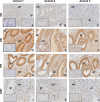The combined impact of testosterone and Western-style diet on endometriosis severity and progression in rhesus macaques†
- PMID: 36173894
- PMCID: PMC9843674
- DOI: 10.1093/biolre/ioac183
The combined impact of testosterone and Western-style diet on endometriosis severity and progression in rhesus macaques†
Erratum in
-
Correction to: The combined impact of testosterone and Western-style diet on endometriosis severity and progression in rhesus macaques.Biol Reprod. 2023 Jul 11;109(1):120. doi: 10.1093/biolre/ioad055. Biol Reprod. 2023. PMID: 37219525 Free PMC article. No abstract available.
Abstract
Polycystic ovary syndrome (PCOS) is associated with irregular menstrual cycles, hyperandrogenemia, and obesity. It is currently accepted that women with PCOS are also at risk for endometriosis, but the effect of androgen and obesity on endometriosis has been underexplored. The goal of this study was to determine how testosterone (T) and an obesogenic diet impact the progression of endometriosis in a nonhuman primate (NHP) model. Female rhesus macaques were treated with T (serum levels approximately 1.35 ng/ml), Western-style diet (WSD; 36% of calories from fat compared to 16% in standard monkey chow) or the combination (T + WSD) at the time of menarche as part of a longitudinal study for ~7 years. Severity of endometriosis was determined based on American Society for Reproductive Medicine (ASRM) revised criteria, and staged 1-4. Stages 1 and 2 were associated with extent of abdominal adhesions, while stages 3 and 4 were associated with presence of chocolate cysts. The combined treatment of T + WSD resulted in earlier onset of endometriosis and more severe types associated with large chocolate cysts compared to all other treatments. There was a strong correlation between glucose clearance, homeostatic model assessment for insulin resistance (HOMA-IR), and total percentage of body fat with presence of cysts, indicating possible indirect contribution of hyperandrogenemia via metabolic dysfunction. An RNA-seq analysis of omental adipose tissue revealed significant impacts on a number of inflammatory signaling pathways. The interactions between obesity, hyperandrogenemia, and abdominal inflammation deserve additional investigation in NHP model species.
Keywords: endometriosis; metabolism; obesity; polycystic ovary syndrome; testosterone.
© The Author(s) 2022. Published by Oxford University Press on behalf of Society for the Study of Reproduction. All rights reserved. For permissions, please e-mail: journals.permissions@oup.com.
Figures


Similar articles
-
Chronic combined hyperandrogenemia and western-style diet in young female rhesus macaques causes greater metabolic impairments compared to either treatment alone.Hum Reprod. 2017 Sep 1;32(9):1880-1891. doi: 10.1093/humrep/dex246. Hum Reprod. 2017. PMID: 28854721 Free PMC article.
-
Chronic hyperandrogenemia in the presence and absence of a western-style diet impairs ovarian and uterine structure/function in young adult rhesus monkeys.Hum Reprod. 2018 Jan 1;33(1):128-139. doi: 10.1093/humrep/dex338. Hum Reprod. 2018. PMID: 29190387 Free PMC article.
-
Individual and combined effects of 5-year exposure to hyperandrogenemia and Western-style diet on metabolism and reproduction in female rhesus macaques.Hum Reprod. 2021 Jan 25;36(2):444-454. doi: 10.1093/humrep/deaa321. Hum Reprod. 2021. PMID: 33313720 Free PMC article.
-
Combined androgen excess and Western-style diet accelerates adipose tissue dysfunction in young adult, female nonhuman primates.Hum Reprod. 2017 Sep 1;32(9):1892-1902. doi: 10.1093/humrep/dex244. Hum Reprod. 2017. PMID: 28854720 Free PMC article.
-
AMERICAN ASSOCIATION OF CLINICAL ENDOCRINOLOGISTS, AMERICAN COLLEGE OF ENDOCRINOLOGY, AND ANDROGEN EXCESS AND PCOS SOCIETY DISEASE STATE CLINICAL REVIEW: GUIDE TO THE BEST PRACTICES IN THE EVALUATION AND TREATMENT OF POLYCYSTIC OVARY SYNDROME - PART 2.Endocr Pract. 2015 Dec;21(12):1415-26. doi: 10.4158/EP15748.DSCPT2. Endocr Pract. 2015. PMID: 26642102 Review.
Cited by
-
Serum creatinine as a risk factor for endometriosis: insights from cross-sectional study, mendelian randomization analysis, and diagnostic model study.BMC Womens Health. 2025 Jun 4;25(1):277. doi: 10.1186/s12905-025-03808-x. BMC Womens Health. 2025. PMID: 40468362 Free PMC article.
-
Initiation of metformin in early pregnancy results in fetal bioaccumulation, growth restriction, and renal dysmorphology in a primate model.Am J Obstet Gynecol. 2024 Sep;231(3):352.e1-352.e16. doi: 10.1016/j.ajog.2024.06.002. Epub 2024 Jun 11. Am J Obstet Gynecol. 2024. PMID: 38871238 Free PMC article.
-
Bats as instructive animal models for studying longevity and aging.Ann N Y Acad Sci. 2024 Nov;1541(1):10-23. doi: 10.1111/nyas.15233. Epub 2024 Oct 4. Ann N Y Acad Sci. 2024. PMID: 39365995 Free PMC article. Review.
-
High-fat diets promote peritoneal inflammation and augment endometriosis-associated abdominal hyperalgesia.bioRxiv [Preprint]. 2023 Nov 13:2023.11.09.566474. doi: 10.1101/2023.11.09.566474. bioRxiv. 2023. Update in: Front Endocrinol (Lausanne). 2024 Mar 15;15:1336496. doi: 10.3389/fendo.2024.1336496. PMID: 38014254 Free PMC article. Updated. Preprint.
-
Western-style diet in the presence of elevated circulating testosterone induces adipocyte hypertrophy without proinflammatory responses in rhesus macaques.Am J Reprod Immunol. 2023 Oct;90(4):e13773. doi: 10.1111/aji.13773. Am J Reprod Immunol. 2023. PMID: 37766405 Free PMC article.
References
-
- Peterson CM, Johnstone EB, Hammoud AO, Stanford JB, Varner MW, Kennedy A, Chen Z, Sun L, Fujimoto VY, Hediger ML, Buck Louis GM, Group ESW . Risk factors associated with endometriosis: importance of study population for characterizing disease in the ENDO study. Am J Obstet Gynecol 2013; 208:451 e451–411. - PMC - PubMed
-
- Liu DT, Hitchcock A. Endometriosis: its association with retrograde menstruation, dysmenorrhoea and tubal pathology. Br J Obstet Gynaecol 1986; 93:859–862. - PubMed
-
- D'Hooghe TM, Bambra CS, Raeymaekers BM, Koninckx PR. Increased prevalence and recurrence of retrograde menstruation in baboons with spontaneous endometriosis. Hum Reprod 1996; 11:2022–2025. - PubMed
Publication types
MeSH terms
Substances
Grants and funding
LinkOut - more resources
Full Text Sources
Medical

